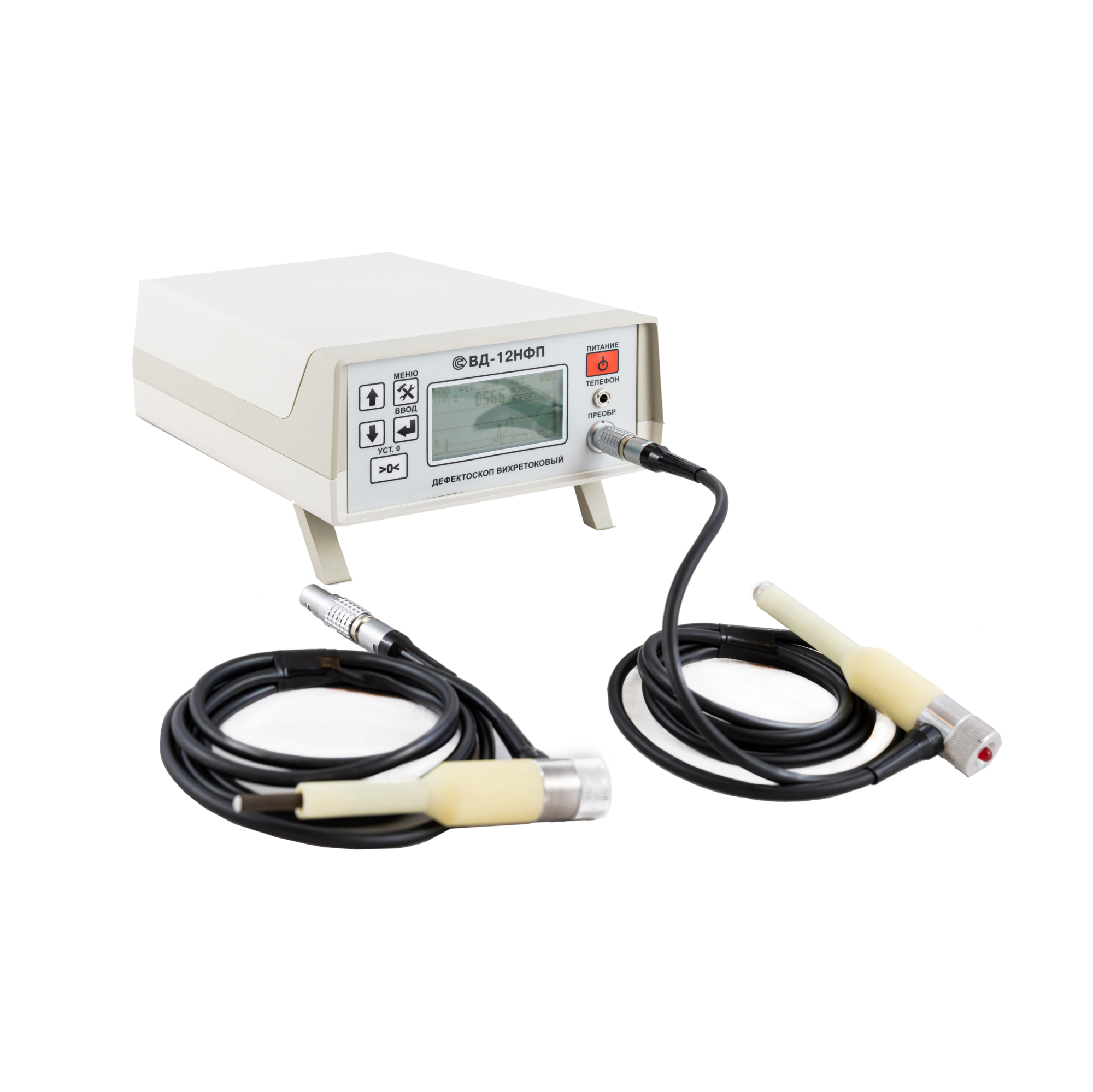NASHA LABA possibilities
Registration
Back to search results
VD-12NFP Eddy Current Flaw Detector with 2 converters
from
292 500 ₽
from
292 500 ₽
Go to the manufacturer's website
The device allows you to detect surface defects like cracks, visualizing the signal from the continuity interruptions on the display. The design of the flaw detector allows to determine with high reliability the exact location and depth of defects even on rough surfaces of flat and curved shape, including under a layer of corrosion or in the presence of a protective coating of the controlled area of the product with a thickness of up to 3 mm.
The principle of operation of the VD-12NFP eddy current flaw detector:
The principle of operation of the VD-12NFP eddy current flaw detector is based on the phenomenon of electromagnetic induction. An alternating magnetic field created in the primary coil of the converter by means of a sinusoidal voltage generator excites eddy currents in the controlled product. A parasitic magnetic field formed by eddy currents at the locations of defects affects the measuring unit (two signal coils connected in series) of the converter, creating an electromotive force in it. The amplitude and phase of the secondary signal carries information about the properties of the defect and the position of the transducer relative to the surface of the controlled product. The output signal from the measuring unit of the converter, after amplification and processing using a microprocessor, is displayed on the readout of the device, and is also stored in the memory block for subsequent transmission to a personal computer. In addition, information about the defects is displayed on a piezoelectric bell used as an audio indicator.
Design, features and advantages of the VD-12NFP eddy current control device:
The VD-12NFP eddy current flaw detector is a portable device capable of working both in a desktop and in a suspended position in a special bag-case. This ensures convenient operation of the device in a variety of conditions: in the laboratory, in the factory shop or during field tests. The flaw detector consists of an electronic unit with controls and display of test results, as well as three replaceable converters with wear-resistant corundum tips connected to the electronic unit using a connector. The choice of the desired converter depends on the magnetic properties of the material. For the control of parts with grooves, a converter with an inclined tip is offered. The device is powered by 4 AA batteries located in the battery compartment of the electronic unit.
The advantages of the flaw detector include:
- a screen for visualizing the signal during measurement;
- light weight and compact dimensions that allow you to use the device in almost any conditions;
- the ability to control the quality of products of various curvature and surface roughness even in the presence of a protective coating or a layer of corrosion;
- wear resistance of converters, which is important when monitoring products with increased surface roughness (up to Rz£320);
- automatic detection of the type of converter when connected, as well as the presence of built-in memory for storing control results;
- the possibility to transfer data to a personal computer for storing or printing control protocols.
Scope of application:
Portability, high productivity, the ability to work with curved and rough surfaces, as well as the fact that the operation of the flaw detector is practically unaffected by humidity, pressure and contamination of the gas environment or the surface of the controlled product with non-conductive substances ensure the versatility of the device for detecting cracks in various materials.
The eddy current flaw detector VD-12NFP is actively used in heavy industry for diagnostics of metal structures, assemblies and mechanisms for various purposes in factory workshops or laboratories, including at enterprises of railway transport, automotive industry, mechanical engineering, pipelines and metal structures.
The VD-12NFP flaw detector can be used with equal success in the field, factory workshops, depots, laboratories and workshops to monitor the current condition, as well as to assess the degree of wear, the possibility and duration of further operation of such products made of metals and alloys as over-spring beams, wagon wheels, auto coupler housings, side frames, wheel couples and others.
Distinctive features:
• control of parts with surface roughness up to Rz320 due to wear-resistant corundum tips;
• assessment of the degree of danger (depth) of the defect;
• automatic detection of the converter type;
• microprocessor control;
• 5 universal programs for saving settings;
• capable of detecting defects with a depth of 0.3 mm
• The angle of deviation of the converter from the normal to the working surface up to 60°
• Operating frequency of 70 kHz;
• Maximum working clearance of 3mm;
• visualization of the signal from the defect;
• built-in memory for storing control results
• Equipped with a Bluetooth 2.0 wireless communication module, which allows you to transmit control results and control the flaw detector at a distance of up to 20m;
• The possibility of forming a control protocol based on the data transmitted to the PC;
• Temperature range from 0°C to +40°C;
• The design allows you to work with the flaw detector without removing it from the bag-case.
Basic kit:
Ia5.173.016: 1 electronic unit
Ia5.125.031: 1 converter, type 1; marked as (•)
Ia5.125.030: 1 converter, type 2; marked as (••)
Ia2.706.002: the KOIDZ-VD set of samples with a passport (consisting of:
Ia8.896.034: 1 piece;
Ia8.896.035: 1 piece;
Ia8.896.035-01: 1 piece) - A certificate of verification.
4 AA batteries
1 charger
1 small-sized phone
1 CD with software
1 special key
1 bag-case
A calibration certificate is issued for the VD-12NFP flaw detector.
1 passport
1 operating manual
1 calibration instruction
The principle of operation of the VD-12NFP eddy current flaw detector:
The principle of operation of the VD-12NFP eddy current flaw detector is based on the phenomenon of electromagnetic induction. An alternating magnetic field created in the primary coil of the converter by means of a sinusoidal voltage generator excites eddy currents in the controlled product. A parasitic magnetic field formed by eddy currents at the locations of defects affects the measuring unit (two signal coils connected in series) of the converter, creating an electromotive force in it. The amplitude and phase of the secondary signal carries information about the properties of the defect and the position of the transducer relative to the surface of the controlled product. The output signal from the measuring unit of the converter, after amplification and processing using a microprocessor, is displayed on the readout of the device, and is also stored in the memory block for subsequent transmission to a personal computer. In addition, information about the defects is displayed on a piezoelectric bell used as an audio indicator.
Design, features and advantages of the VD-12NFP eddy current control device:
The VD-12NFP eddy current flaw detector is a portable device capable of working both in a desktop and in a suspended position in a special bag-case. This ensures convenient operation of the device in a variety of conditions: in the laboratory, in the factory shop or during field tests. The flaw detector consists of an electronic unit with controls and display of test results, as well as three replaceable converters with wear-resistant corundum tips connected to the electronic unit using a connector. The choice of the desired converter depends on the magnetic properties of the material. For the control of parts with grooves, a converter with an inclined tip is offered. The device is powered by 4 AA batteries located in the battery compartment of the electronic unit.
The advantages of the flaw detector include:
- a screen for visualizing the signal during measurement;
- light weight and compact dimensions that allow you to use the device in almost any conditions;
- the ability to control the quality of products of various curvature and surface roughness even in the presence of a protective coating or a layer of corrosion;
- wear resistance of converters, which is important when monitoring products with increased surface roughness (up to Rz£320);
- automatic detection of the type of converter when connected, as well as the presence of built-in memory for storing control results;
- the possibility to transfer data to a personal computer for storing or printing control protocols.
Scope of application:
Portability, high productivity, the ability to work with curved and rough surfaces, as well as the fact that the operation of the flaw detector is practically unaffected by humidity, pressure and contamination of the gas environment or the surface of the controlled product with non-conductive substances ensure the versatility of the device for detecting cracks in various materials.
The eddy current flaw detector VD-12NFP is actively used in heavy industry for diagnostics of metal structures, assemblies and mechanisms for various purposes in factory workshops or laboratories, including at enterprises of railway transport, automotive industry, mechanical engineering, pipelines and metal structures.
The VD-12NFP flaw detector can be used with equal success in the field, factory workshops, depots, laboratories and workshops to monitor the current condition, as well as to assess the degree of wear, the possibility and duration of further operation of such products made of metals and alloys as over-spring beams, wagon wheels, auto coupler housings, side frames, wheel couples and others.
Distinctive features:
• control of parts with surface roughness up to Rz320 due to wear-resistant corundum tips;
• assessment of the degree of danger (depth) of the defect;
• automatic detection of the converter type;
• microprocessor control;
• 5 universal programs for saving settings;
• capable of detecting defects with a depth of 0.3 mm
• The angle of deviation of the converter from the normal to the working surface up to 60°
• Operating frequency of 70 kHz;
• Maximum working clearance of 3mm;
• visualization of the signal from the defect;
• built-in memory for storing control results
• Equipped with a Bluetooth 2.0 wireless communication module, which allows you to transmit control results and control the flaw detector at a distance of up to 20m;
• The possibility of forming a control protocol based on the data transmitted to the PC;
• Temperature range from 0°C to +40°C;
• The design allows you to work with the flaw detector without removing it from the bag-case.
Basic kit:
Ia5.173.016: 1 electronic unit
Ia5.125.031: 1 converter, type 1; marked as (•)
Ia5.125.030: 1 converter, type 2; marked as (••)
Ia2.706.002: the KOIDZ-VD set of samples with a passport (consisting of:
Ia8.896.034: 1 piece;
Ia8.896.035: 1 piece;
Ia8.896.035-01: 1 piece) - A certificate of verification.
4 AA batteries
1 charger
1 small-sized phone
1 CD with software
1 special key
1 bag-case
A calibration certificate is issued for the VD-12NFP flaw detector.
1 passport
1 operating manual
1 calibration instruction
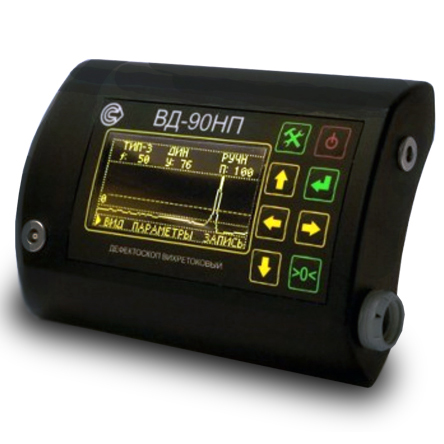
VD-90NP Eddy current flaw detector in the basic configuration
from
398 250 ₽
The principle of operation of the device:
The principle of operation of the flaw detector is based on the excitation of eddy currents in the controlled product and the subsequent release of a signal at the output of the converter, the amplitude and phase of which are determined by the secondary field of eddy currents.
Design features and advantages of the VD-90NP flaw detector.
The device has a small-sized case, which ensures its lightness, ergonomics and allows you to mount it on your belt or on your arm. The measurement is performed using a remote converter connected by a flexible cable. There are several types of converters for eddy current flaw detection of products made of different materials and different geometries. The large and bright display displays the selected operating modes and measurement results in text and graphic form. The VD-90NP is also characterized by:
high sensitivity (it detects cracks starting from 0.1 mm in size);
dust–and-moisture-proof housing, which makes it applicable for work in the field;
large operating frequency range;
maximum working clearance up to 10mm;
Bluetooth connection;
the ability to control products with high surface roughness, up to Rz320 class;
light and sound indication of defect detection;
wide operating temperature range from –30°C to +50°C;
autonomous low-voltage power supply;
long continuous operation time from one set of batteries;
compliance with the standard GOST R ISO 15549-2009 (ISO 15549:2008).
The use of a microprocessor-based hardware and software platform provide it with the following operational characteristics:
automatic adjustment when measuring conditions change, including compensating the influence of the gap;
built-in calibration modes;
saving the measurement results in the internal memory of the device;
a large number of stored programs: sets of parameters and measurement modes, both preset and saved by the user so as to repeatedly monitor the same type of products;
The Bluetooth 2.0 wireless communication module allows the device to be used in conjunction with an external laptop or mobile device for remote control, transmission of measurement results for further storage, printing, documentation and analysis.
Scope of application:
The eddy current method is suitable for non-destructive testing and detection of microcracks in products and parts made of any metals and alloys of complex shape, with high surface roughness, through non-conductive coatings, as well as for checking welded joints. The flaw detector can be used to control parts and assemblies of aviation equipment.
The VD-90NP eddy current flaw detector is used for quality control and preventive examination of:
- components and parts of rolling stock at railway transport enterprises: wheel sets, auto coupler housings, side frames, spring beams, labyrinth rings, pulleys;
- pipes, profiles, rods at rolling mills at the output control, and at the input control of consumers of products;
- products made of aluminum and titanium alloys with multilayer coatings at enterprises of the aviation and aerospace industry;
- cables, beams, critical components of equipment (cranes, lifts) in construction;
- main pipelines in order to detect stress corrosion.
A wide range of operating temperatures, dust and moisture protection (IP54 degree of protection), autonomous low-voltage power supply, a long time of continuous operation of the device allows it to be used in the field at low temperatures and under precipitation (rain, snow).
Basic kit:
• 1 electronic unit for the VD-90NP eddy current flaw detector;
• 1 Ia5.125.052 (Type-2) eddy current converter;
• 1 converter cable;
• 1 charger with batteries;
• 1 hand strap;
• 1 Ia8.896.104 sample with artificial defects;
• 1 Ia8.896.035 coating sample;
• 1 storage and carrying case;
• 1 documentation set.
RII MNPO SPEKTR
Moscow
Produced in: Moscow
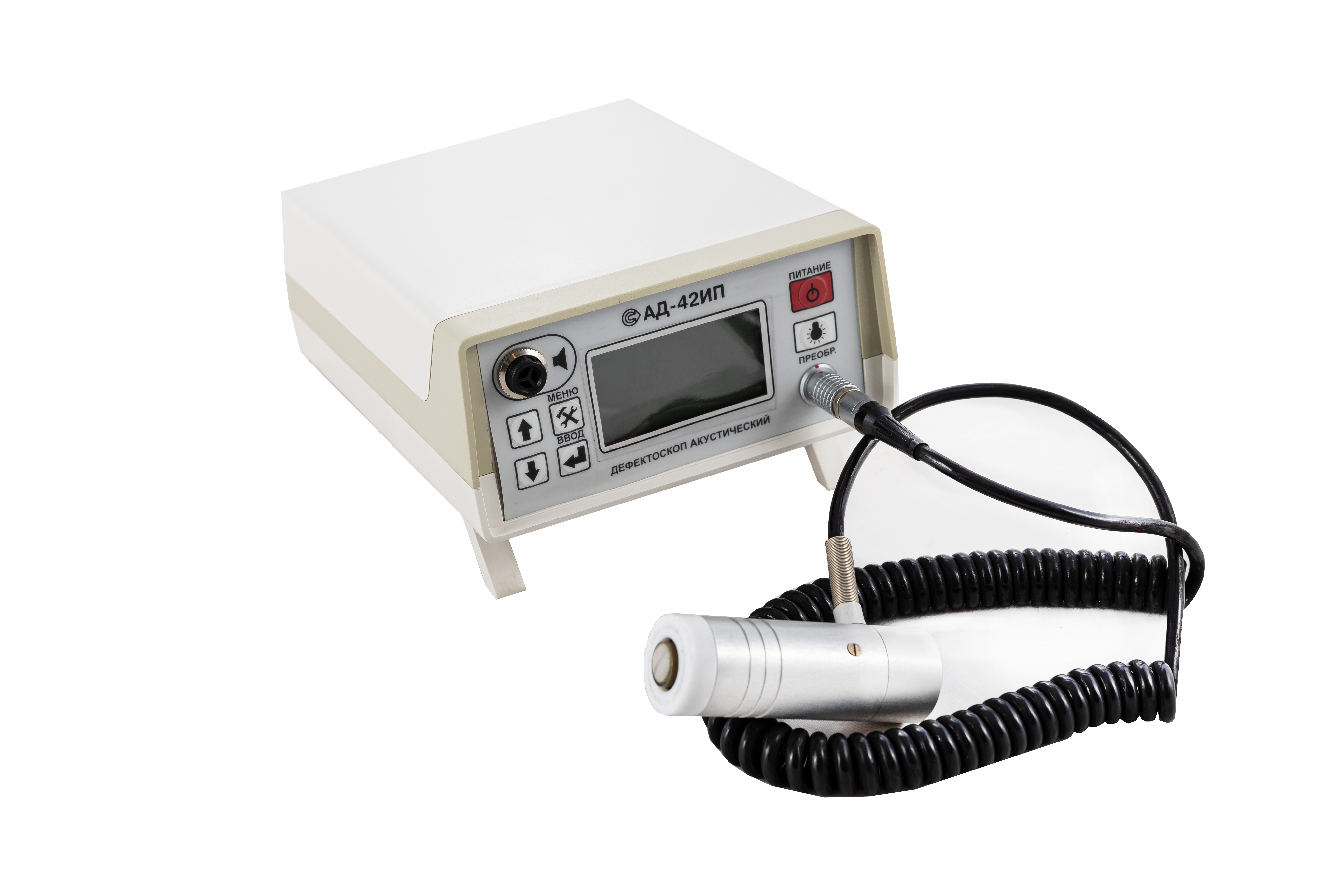
AD-42IP Acoustic Flaw Detector
from
442 500 ₽
It is especially effective for use in products made of composite materials (including with honeycomb filler).
Distinctive features:
The AD-42 IP is a compact acoustic system sensitive to changes in mechanical impedance caused by product defects. The indication of the device indicates that there are voids, non-adhesives, delaminations or changes in the structure of composite materials (including with honeycomb filler and laminated plastics) under the sensor.
The device is used to monitor various materials and their combinations.
The energy consumption of the unit is low because the converter is switched on when the sensor is placed on the monitored product.
Being light enough, the device allows you to perform monitoring in hard-to-reach places or in confined spaces.
The results of the control can be stored in the built-in non-volatile memory and transferred to a PC.
Converters
Options: - 3 types of converters for various tasks
Emitters: - 1 or 2 on each converter
Switching-on: - The converters are switched on when they are placed on a controlled object.
Technical characteristics:
Weight, kg: 0.73
Dimensions, mm: 210x150x70
Power supply: 4 AA batteries
Work without recharging the battery, h: 8
Battery discharge visual indication
The defect alarm is visual on the converter and audible on the instrument panel (or) in headphones.
RII MNPO SPEKTR
Moscow
Produced in: Moscow
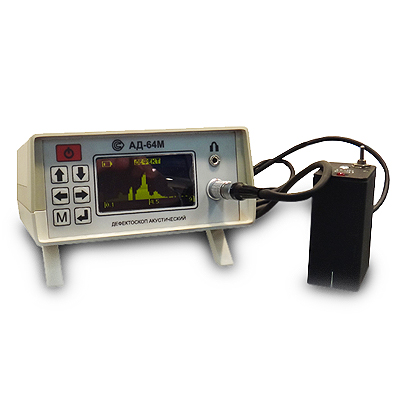
AD-64M Acoustic Impedance Flaw Detector
from
825 000 ₽
Control methods: Impedance method (IM) and free oscillation method (MSC)
Distinctive features:
- A wide range of controlled materials: from steel to foam and structures with soft external and internal elements
- Application of two complementary control methods
- One-way access
- Dry contact of the transducers with the controlled object
- Visual representation of information
- The ability to memorize and reproduce the setting modes, which excludes the use of control samples at the workplace
Technical specifications:
The minimum area of the detected defect, cm2: 1
The depth of detected defects in fiberglass, mm: up to 12...15
Light and sound signaling of defects
Number of measurements per second: 15
Weight, kg: 1
Self-powered by batteries
Continuous battery life, h: 8
Operating temperature range, °C: -10...40
RII MNPO SPEKTR
Moscow
Produced in: Moscow
May be interested in
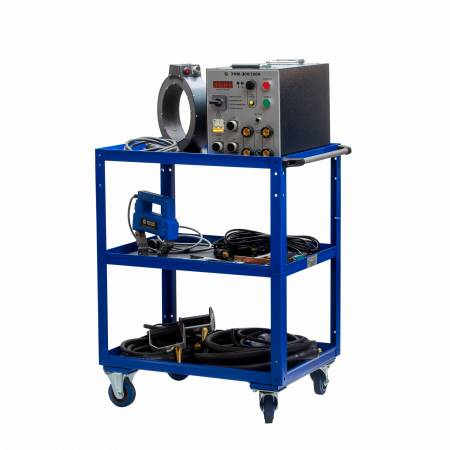
UNM-300/2000 portable magnetizing device
The principle of operation of the magnetic particle flaw detector:
The device provides monitoring and detection of surface defects by the applied field method or by the residual magnetization method.
The kit with the device includes power cables, remote solenoids, and an electromagnet, with which you can produce longitudinal or circular magnetization of the part. A trolley is provided for the transportation of technical equipment and the detection of defects in the field. Magnetization is carried out by alternating, direct or pulsed current of large magnitude, due to which high values of the magnetizing field strength are achieved.
Features and advantages of the UNM-300/2000 magnetic powder control device:
Microprocessor control, which allows you to memorize and accurately reproduce the desired modes and selected measurement parameters, as well as work as part of automated stands and control systems;
The magnetizing device has a digital indicator on the front side and a control panel for selecting the operating mode, type and current strength;
Automatic recognition of the type of connected external magnetizing device;
Device temperature control and automatic shutdown in case of overheating;
Remote connected magnetization devices allow you to control the quality of parts and assemblies of complex shape;
Automatic demagnetization of controlled assemblies and parts;
The equipment meets the requirements of the following standards: GOST R 56512-2015, GOST R 53700-2009 (ISO 9934-3:2002), GOST R 50.05.06-2018, GOST R ISO 10893-5-2016, GOST ISO 17638-2018, RD 34.17.102-88 and RD-13-05-2006;
Devices of the MANUL series (UNM-300/2000 and others) are approved for use by the Russian Railways.
Scope of application:
Magnetic particle flaw detection is indispensable where quality control of various critical and loaded assemblies and parts is required, detection of surface defects that occur during their production, storage and operation.
The device may be in demand:
at factories for the production and repair of automotive, aviation and railway equipment, metro enterprises, military-industrial complex (inspection of shafts, axles, wheel pairs, pistons, beams, springs, etc.);
in civil and military shipbuilding, elevator and crane enterprises (control of rigging equipment, hooks, etc.);
at pipe rolling plants (determination of defects in rolled products);
in the oil and gas, chemical industry (inspection of welds of equipment operating under pressure).
The UNM-300/2000 portable magnetic particle flaw detector has a relatively small weight and dimensions, which allow it to be used as a stationary or portable device in specialized quality control laboratories or in ordinary workshops, garages, hangars, locomotive depots or warehouses.
The UNM 300/2000 device, as well as other means of magnetic powder control, are normally used together with auxiliary equipment for the preparation and application of magnetic powder (suspension), for fixing the indicator pattern, magnetometers for determining residual magnetization, visual inspection means – magnifiers and endoscopes, as well as with ultraviolet irradiators in the case of fluorescent powders.
Technical specifications
Magnetization currents
Variable,
Pulse,
Rectified (only for solenoid and electromagnet)
The measurement error of the magnetization current is no more than 10%.
characteristics of the pulse current
The repetition frequency of unipolar current pulses during magnetization and of multipolar current pulses during demagnetization is (2 ± 0.2) Hz.
The duration of the current pulses is at least 1.5 ms.
Magnetic characteristics of the solenoid
The maximum alternating magnetic field in the center of a single solenoid is at least 100 A/cm.
The maximum alternating magnetic field on the axis in the center between two solenoids located at a distance of 200 mm is at least 60 A/cm.
The maximum permanent magnetic field in the center of a single solenoid is at least 80 A/cm.
The maximum permanent magnetic field on the axis in the center between two solenoids located at a distance of 200 mm is at least 50 A/cm.
Values of magnetization currents
The maximum alternating magnetization current in the unwound cable 6 m × 50 mm2 and on the electrical contacts is at least 1000 A.
The maximum pulse magnetization current in an unwound cable of 4 m × 10 mm2 and on electrical contacts is at least 2000 A.
The current adjustment range in the solenoids and the electromagnet is from 0.5 to 4.5 A.
Characteristics of the electromagnet
The maximum alternating magnetic field in the air gap of the electromagnet depending on the interpolar distance is as follows:
- in the 140 mm gap: at least 75 A/cm;
- in the 40 mm gap: at least 300 A/cm.
The maximum constant magnetic field in the air gap of the electromagnet depending on the interpolar distance is as follows:
- in the 140 mm gap: at least 100 A/cm;
- in the 40 mm gap: at least 400 A/cm.
Operating mode
The operating mode is cyclic: magnetization/pause.
The magnetization time is adjustable from 1 to 40 s.
The demagnetization time is adjustable from 5 to 60 seconds.
Demagnetization of details is performed automatically.
The time of setting the operating mode is no more than 15 seconds.
The duration of continuous operation is at least 8 hours.
Power supply parameters
The device is powered by an alternating current network with a voltage of 220 V and a frequency of 50 Hz.
The power consumed from the network is no more than 5 kVA.
weight and size characteristics
Overall dimensions of the device (w × h × d) – no more than 267×245×465 mm.
The weight of the device is not more than 50 kg.
Other characteristics
The average worktime before failure is at least 12500 hours.
The average recovery time is no more than 6 hours.
The average service life of the device is at least 10 years.
Compliance with standards
The device fully complies with the requirements of GOST R 56512-2015, GOST R 53700-2009 (ISO 9934-3:2002), GOST R 50.05.06-2018, GOST R ISO 10893-5-2016, GOST ISO 17638-2018, RD 34.17.102-88 and RD-13-05-2006 in terms of the requirements for magnetizing devices and magnetic particle flaw detectors.
Identification of the load.
It performs automatic identification of the types of connected load: cables, solenoids and electromagnet.
Control of the connected load current
It allows you to control the current of the connected AC/DC electromagnets and solenoids.
RII MNPO SPEKTR
Moscow
Produced in: Moscow

MI-10X Magnetic Indicator
from
22 500 ₽
Distinctive features.
Compactness
Autonomy
Maximum ease of handling
Energy saving mode
Technical specifications
Indication of induction levels, MT,:
weak magnetization 0...2
average magnetization 2...10
strong magnetization more than 10
Power supply 1 accumulator unit or PP3 battery
Current consumption, mA, no more than 8
Operating temperature range, °C -30...+50
Dimensions of the electronic unit, mm 90x50x32
Dimensions of the converter, mm 14x50
RII MNPO SPEKTR
Moscow
Produced in: Moscow
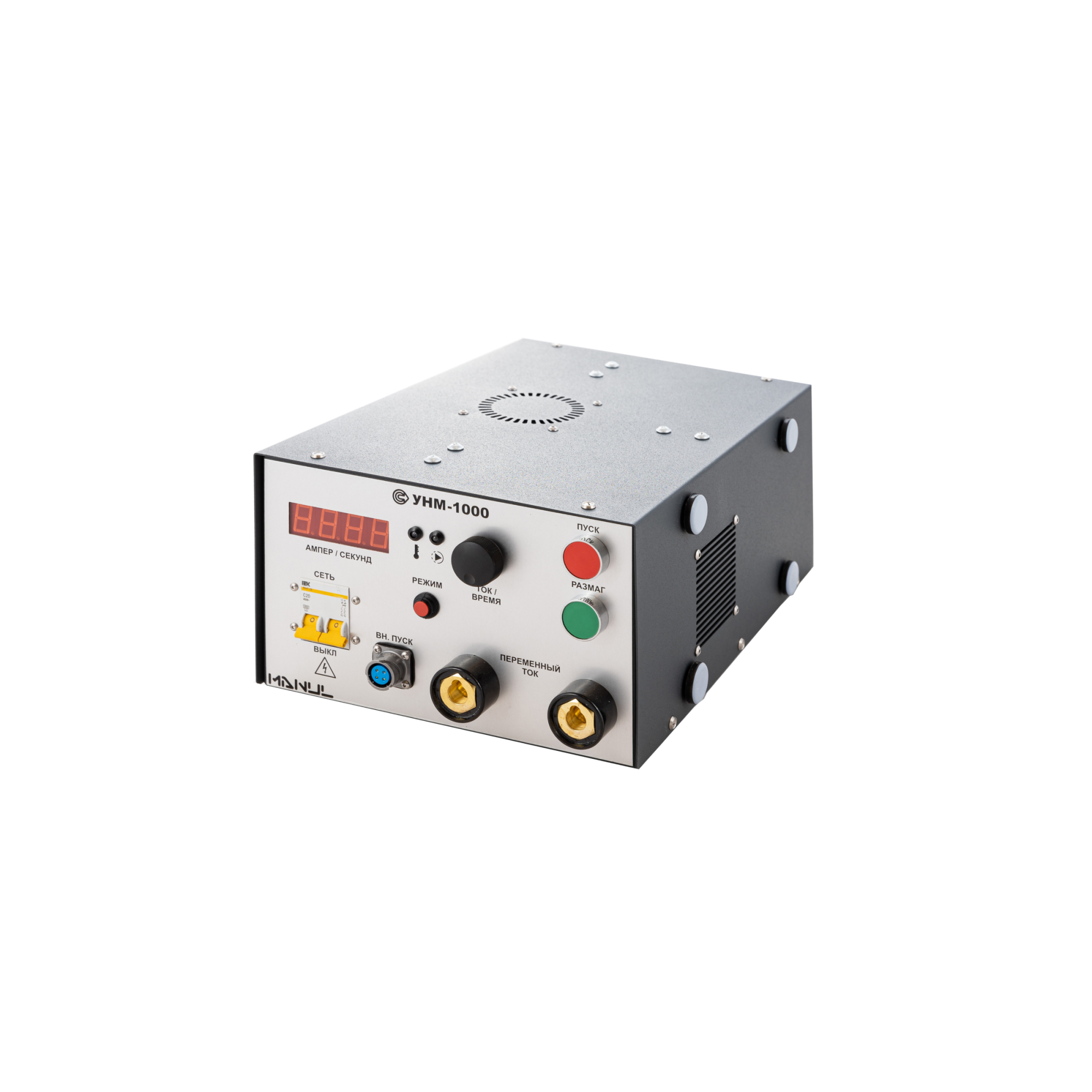
UNM-1000 portable magnetizing device, power unit
from
552 000 ₽
The UNM-1000 allows to detect internal, subsurface and surface defects of different types (cracks, flokens, delaminations, defects of welding seams, etc.) in parts, structural elements, units and mechanisms of industrial units, railway, auto, air vehicles, as well as petrochemical, gas and technological equipment during the manufacturing and repair stages or during routine inspections of the products being in operation.
The principle of operation of the UNM-1000 AC flaw detector
The magnetic powder method of detecting defects in products made of ferromagnetic materials is based on the ability of magnetic powder particles to settle in the defect zone, where inhomogeneities of the magnetic field created by the magnetizing device arise. Unlike devices based on permanent magnets, magnetic particle flaw detectors allow you to set the current and time of magnetization and automatically demagnetize controlled samples.
The UNM-1000 AC flaw detectors allow monitoring of products by the applied field method using various magnetization techniques. To do this, the alternating electric current generated by the flaw detector can be passed through a magnetizing cable or directly through a controlled product connected to the flaw detector using electrical contacts. The value of the current used for magnetization and demagnetization of the product is set by the operator of the device.
Design features and advantages
The UNM-1000 flaw detector is a portable device, which allows you to control the quality of products made of ferromagnetic materials both in production and in laboratory conditions. The basic set of equipment for magnetic particle flaw detection includes a UNM-1000 magnetizing device, a power cable for power supply from a single-phase AC network with a voltage of 220 V, and technical documentation. At the request of the customer, electrical contacts and a magnetizing AC cable can be additionally supplied.
The advantages of the UNM-1000 device of the MANUL series include:
the possibility of monitoring both in the applied magnetic field with longitudinal magnetization using power cables, and with circular magnetization by passing current through the controlled product;
wide range of magnetization current adjustment from 50 to 1000 A;
automatic demagnetization of controlled products;
high performance;
the device is compact and has light weight;
the degree of protection from external influences is at least IP40.
Scope of application of magnetic particle control means
Due to its versatility, simplicity and ease of operation, the UNM-1000 magnetic particle flaw detector can be used in almost all non-destructive testing laboratories of workshops and assembly shops of the automotive and aviation industries, railway transport, for the needs of civil and military shipbuilding. Also, the UNM-1000 magnetic powder control device can be successfully used in the energy sector, in the production of pipelines, metal structures, construction equipment and related industries. Technical characteristics of the portable magnetizing device UNM-1000 fully complies with the requirements of the following standards: GOST R 56512-2015, GOST R 53700-2009 (ISO 9934-3:2002), GOST R 50.05.06-2018, GOST R ISO 10893-5-2016, GOST ISO 17638-2018, RD 34.17.102-88, RD-13-05-2006 , as well as other national and foreign regulations documents on standardization of magnetizing devices and flaw detectors for magnetic powder control.
Technical specifications
• Magnetization current: up to 1000A (RMS), 4.3V,50 Hz
• Demagnetization mode
• Weight: no more than 20kg
• Overall dimensions (W×H×D): 290×160×450 mm
• The device is powered by 220V, 50 Hz
RII MNPO SPEKTR
Moscow
Produced in: Moscow
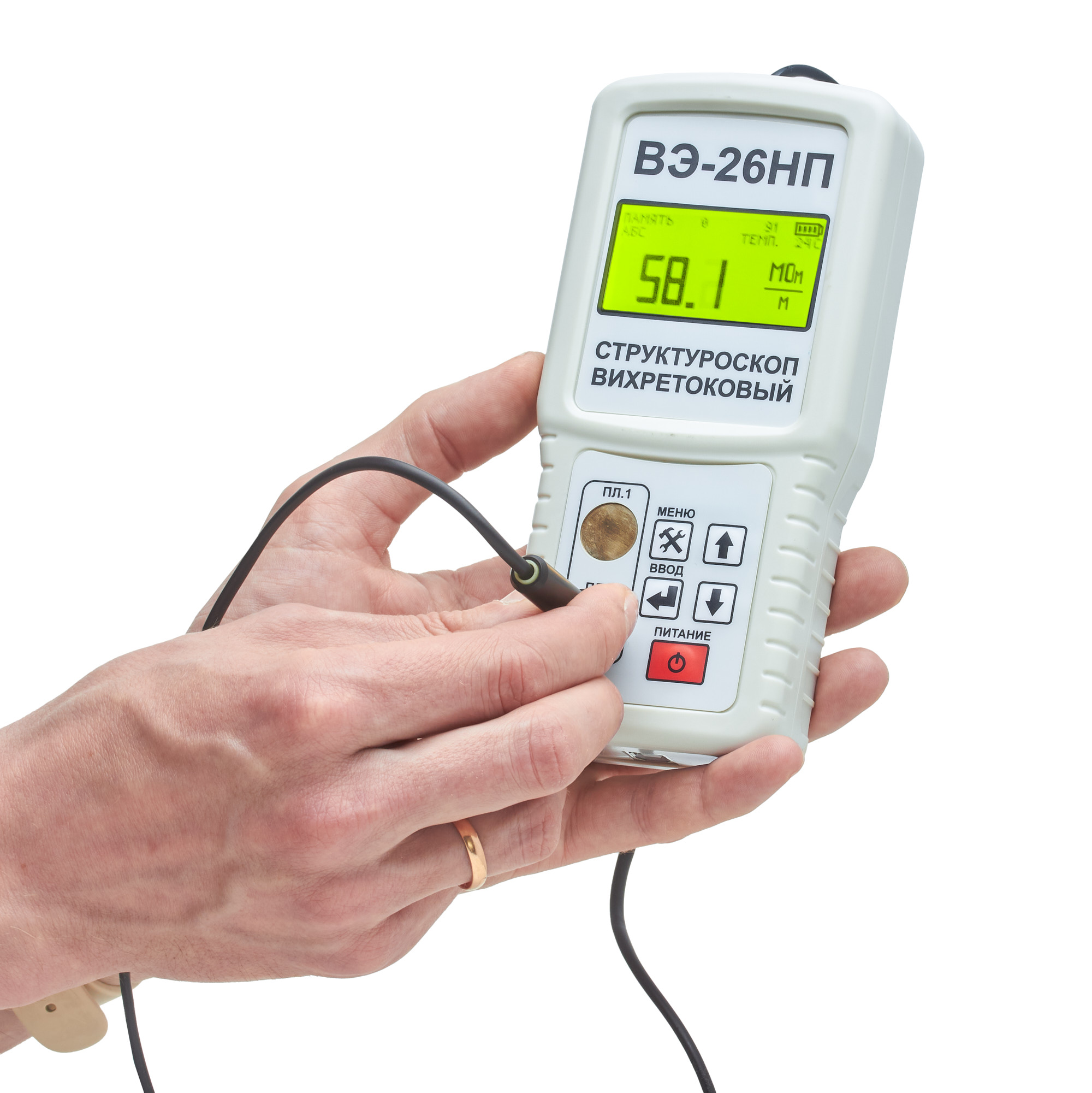
VE-26NP Eddy current structuroscope
from
195 000 ₽
Distinctive features:
The built-in thermometer allows you to take into account the influence of ambient temperature and improve the measurement accuracy. The built-in memory stores 4096 electrical conductivity measurement results for subsequent transfer to a PC.
Specifications:
Measuring range of the absolute value of specific electrical conductivity, MSm/m from 5 to 60
Measuring range of increments of electrical conductivity, MS/m from -9.99 to +9.99 Limit of permissible basic relative measurement error, % no more than 2 Permissible gap between the transducer and the surface of the controlled product, mm, no more than 0.25 Digital display of measurement results Power supply from RRZ type battery, V 9 Power consumption, mW, no more than 40 Operating temperature range, °C 5...40 Dimensions, mm 57*84*30 Weight, g 270±20
Measuring range of increments of electrical conductivity, MS/m from -9.99 to +9.99 Limit of permissible basic relative measurement error, % no more than 2 Permissible gap between the transducer and the surface of the controlled product, mm, no more than 0.25 Digital display of measurement results Power supply from RRZ type battery, V 9 Power consumption, mW, no more than 40 Operating temperature range, °C 5...40 Dimensions, mm 57*84*30 Weight, g 270±20
RII MNPO SPEKTR
Moscow
Produced in: Moscow

AD-64M Acoustic Impedance Flaw Detector
from
825 000 ₽
Control methods: Impedance method (IM) and free oscillation method (MSC)
Distinctive features:
- A wide range of controlled materials: from steel to foam and structures with soft external and internal elements
- Application of two complementary control methods
- One-way access
- Dry contact of the transducers with the controlled object
- Visual representation of information
- The ability to memorize and reproduce the setting modes, which excludes the use of control samples at the workplace
Technical specifications:
The minimum area of the detected defect, cm2: 1
The depth of detected defects in fiberglass, mm: up to 12...15
Light and sound signaling of defects
Number of measurements per second: 15
Weight, kg: 1
Self-powered by batteries
Continuous battery life, h: 8
Operating temperature range, °C: -10...40
RII MNPO SPEKTR
Moscow
Produced in: Moscow
Reviews
There are no entries.

